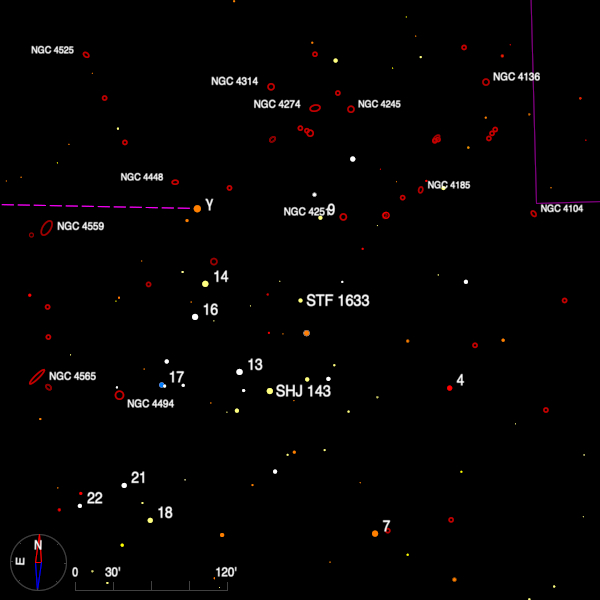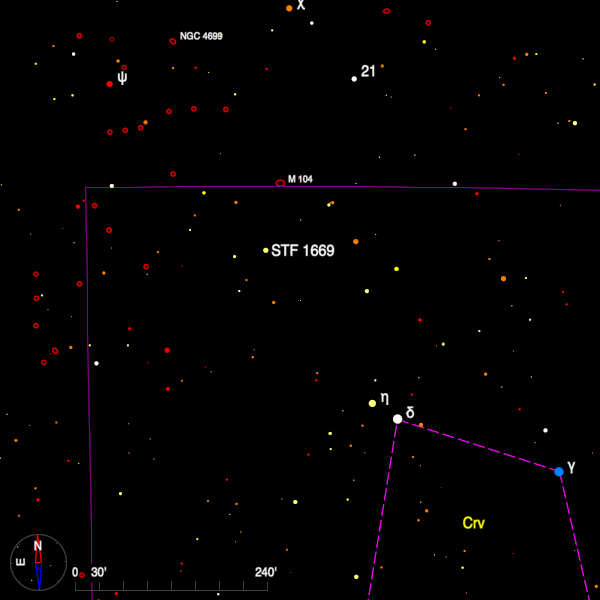Double Star of the Month in Corvus
-
April 2023 - Double Star of the Month
In the constellation Coma Berenices, in addition to the famous cluster of galaxies, there is also a grouping of naked-eye stars about 13 degrees north of the galaxy cluster. Taking the pairs 12 and 13 Comae and 14 and 16 as the vertices of an isosceles triangle, then the third vertex is occupied by STF 1633 (12 20 41.33 +27 03 16.4) a beautiful pair described by Webb as
Very pretty. Solitary.
Observing it with a 21-cm reflector I found the colours to be yellow and delicate light blue.
A finder chart for the double star STF 1633 in Coma Berenices created with Cartes du Ciel. Of the four bright stars in the 'triangle' only 12 appears to be in the double star catalogue. Also known as SHJ 143, this is a wide, unequal pair in 15-cm (magnitudes 4.9, 8.9, 167 degrees, 65") which should also show the more elusive 11.8 magnitude star at 57 degrees, 37" to A.
Just over a degree south of the Sombrero galaxy (M104), and over the border into Corvus is STF 1669 (12 41 16.22 -13 00 53.6) a beautiful visual double which turns out to be at least a physical quadruple star under the gaze of the spectroscope.

A finder chart for the double star STF 1669 in Corvus created with Cartes du Ciel. The AB components are both magnitude 5.9 and the current position and angle and separation is 314 degrees and 5".3. This shows a change of +15 degrees and -1".6 since being measured by Struve in 1828.
A third star (C) of magnitude 10.3 is 46" away in position angle 228 degrees. Strangely, Gaia DR3 records similar values for the trigonometrical parallax of stars A and C (equivalent to a distance of 266 light-years) whilst the B component is significantly nearer us (235 light-years) but is certainly regarded as physical by Dr. Andrei Tokovinin is his Multiple Star Catalog (MSC). The MSC notes that A has a period of 44.5 days whilst that of B is 3.15 days.
Bob Argyle - Double Star Section Director
-
April 2018 - Double Star of the Month
Just 6 degrees north of Denebola (beta Leo) sits 93 Leo (11 47 59.23 +20 13 08.2) a rather undistinguished white star of magnitude 4.6.
It caught the attention of William Herschel in 1782 who called it H VI 80. Some 40 years later it came to the attention of F. G. W. Struve during the Dorpat survey but the companion star at magnitude 9.0 and distance 77" did not impress him enough to put in the main catalogue, so it was relegated to one of the two Appendix Catalogues of essentially wide pairs.
In 1900, the primary was found to be a spectroscopic binary by Campbell and Wright at Lick Observatory where four spectra of the star showed a range of 38 kms per second.
More recently 93 Leo has been shown to be an RS CVn star, a variable type which involves chromospheric activity on one component of a pair of giant stars, in this case the spectral types are F8III and A6III.
The period was shown to be almost 72 days and then the Mark III interferometer (which was based at Mount Wilson Observatory but closed in 1992) resolved the two stars and defined a visual orbit of great precision even though the separation varied from only 5 to 8 milliseconds of arc.
Hipparcos showed the primary star to be 232 light years away but the companion has recently been observed by Gaia which shows that it is at the same distance and moving through space with the same proper motion as A making this a physical triple system.
Smyth neglects to include in his catalogue. Webb notes a curiously similar pair in the field. This is SHJ 130 (7.5, 10.0, 30 degrees, 71") and is about 13 arc-minutes south-west of 93 Leo.
STF 1604 (12 09 28.54 -11 51 25.4) lies in a barren area of sky on a line between beta Virginis and gamma Corvi and about 6 degrees along the line from the latter star.
There are three components for the small telescope, although the B star is rather faint and is of late spectral type.
AB is magnitude 6.9 and 10 at 89 degrees, separated by 9" (2016). Both components have a significant and similar proper motion and have been approaching the third unconnected star C (magnitude 8.1) since 1831 when the distance AC was 58 arc-seconds. Closest approach was 9".6 in 1983, and I measured the distance at 10".8 in 2017.
The stars were in Virgo when Webb wrote his book but have now sneaked over the border into northern Corvus.
Bob Argyle - Double Star Section Director
-
April 2016 - Double Star of the Month
STF 1517 (11 13 41.22 +20 07 44.9) is very easy to find. It is about 30 arc minutes south and slightly west of the 3rd magnitude delta Leonis. Found by F. G. W. Struve at Dorpat, this binary appears to be moving in an orbit which is very highly inclined. Motion is therefore mostly in separation and between 1820 and the late 1890s the stars closed from more than 1 arc second to about one-quarter of an arc second. After that the quadrant changed and they began to separate. The proper motion of the system is large enough that we can say the system is definitely physical. The USNO Sixth Orbit Catalogue gives a period of 924 years which is highly speculative as the motion has been virtually linear since discovery.
The calculated position for early 2016 is 316° and 0".71 making it a good test for 20-cm. The stars are of similar brightness but a little on the faint side (mags 7.5 and 8.0). As part of his proper motion programme, Burnham added a star of mag 10.8 at 246" and 97° but the distance is increasing rapidly due to the proper motion of 0".4 annually in the bright pair.
BU 28 (12 30 04.93 -13 23 35.0) is one of Burnham's most interesting discoveries. Its low number tells us that it was in Burnham's first list of 81 new pairs which he published in MNRAS in 1873. Burnham often underestimated the magnitude of the fainter star in very close and unequal pairs and in this case he assigned a value of 12 to the magnitude of B, calling the pair
a very delicate and beautiful double star
. The WDS gives 9.6 with the primary at 6.4. It is marked in the Cambridge Double Star Atlas 1st edition but without a label.This is a pair with a period of 151 years and the separation ranges from less than 0".4 to 2".2 which, fortuitously, is where it is at present, so now is the very best opportunity to observe these stars. It is found 3 degrees due north of delta Corvi, but the low declination from the UK means that a good steady night is required. The writer has not yet looked at this system but will put it on his 'to do' list. BU 28 is 80 light years distant and moving across the sky at more than 0".25 per year. It is leaving behind two distant comites (mags 10.6 and 11.6) which are currently both 71" distant.
Bob Argyle - Double Star Section Director